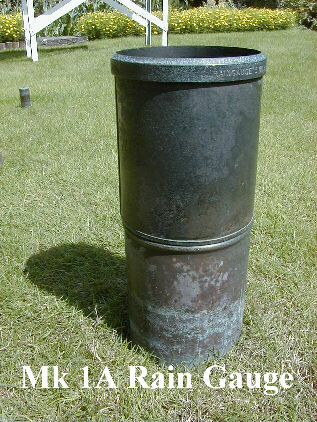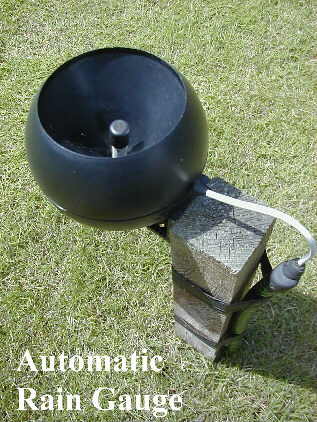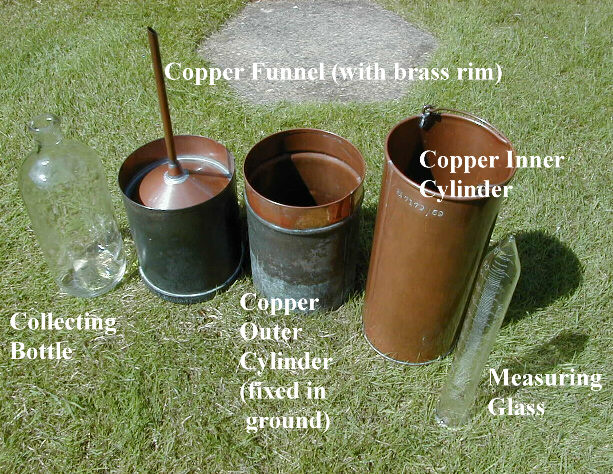

Royston (Iceni) Weather Station
Royston Rainfall from 1853
Rainfall records have been maintained in Royston since January 1853 at several sites within about 1 km of Royston (Iceni) Weather Station. This invaluable series of rainfall data has been continued at Royston (Iceni) Weather Station since May 1972.
This data is in the process of being keyed to computer and archived to DVD. The present availability of Royston rainfall data is shown in the Data available by E-Mail File Attachment page.
Tables of monthly rainfall totals in 25 Year periods may be viewed by clicking on the links below.
| 1853/1875 | 1876/1900 | 1901/1925 | |||
| 1926/1950 | 1951/1975 | 1976/2000 | |||
| 2001/2025 |
Similarly, bar charts of annual rainfall totals in 25 Year periods are available by clicking on the following links.
| 1853/1875 | 1876/1900 | 1901/1925 | |||
| 1926/1950 | 1951/1975 | 1976/2000 |
For annual bar charts showing monthly rainfall totals in each year click on the links below.
Year:
| 1850 | 1851 | 1852 | 1853 | 1854 | 1855 | 1856 | 1857 | 1858 | 1859 | ||||||||||
| 1860 | 1861 | 1862 | 1863 | 1864 | 1865 | 1866 | 1867 | 1868 | 1869 | ||||||||||
| 1870 | 1871 | 1872 | 1873 | 1874 | 1875 | 1876 | 1877 | 1878 | 1879 | ||||||||||
| 1880 | 1881 | 1882 | 1883 | 1884 | 1885 | 1886 | 1887 | 1888 | 1889 | ||||||||||
| 1890 | 1891 | 1892 | 1893 | 1894 | 1895 | 1896 | 1897 | 1898 | 1899 | ||||||||||
| 1900 | 1901 | 1902 | 1903 | 1904 | 1905 | 1906 | 1907 | 1908 | 1909 | ||||||||||
| 1910 | 1911 | 1912 | 1913 | 1914 | 1915 | 1916 | 1917 | 1918 | 1919 | ||||||||||
| 1920 | 1921 | 1922 | 1923 | 1924 | 1925 | 1926 | 1927 | 1928 | 1929 | ||||||||||
| 1930 | 1931 | 1932 | 1933 | 1934 | 1935 | 1936 | 1937 | 1938 | 1939 | ||||||||||
| 1940 | 1941 | 1942 | 1943 | 1944 | 1945 | 1946 | 1947 | 1948 | 1949 | ||||||||||
| 1950 | 1951 | 1952 | 1953 | 1954 | 1955 | 1956 | 1957 | 1958 | 1959 | ||||||||||
| 1960 | 1961 | 1962 | 1963 | 1964 | 1965 | 1966 | 1967 | 1968 | 1969 | ||||||||||
| 1970 | 1971 | 1972 | 1973 | 1974 | 1975 | 1976 | 1977 | 1978 | 1979 | ||||||||||
| 1980 | 1981 | 1982 | 1983 | 1984 | 1985 | 1986 | 1987 | 1988 | 1989 | ||||||||||
| 1990 | 1991 | 1992 | 1993 | 1994 | 1995 | 1996 | 1997 | 1998 | 1999 | ||||||||||
| 2000 | 2001 | 2002 | 2003 | 2004 | 2005 | 2006 | 2007 | 2008 | 2009 | ||||||||||
| 2010 | 2011 | 2012 |
 |
 |
| These photographs show the instruments used to measure rainfall at Royston (Iceni) Weather Station. The instrument above is the M O Mk 1A rain gauge which is checked daily at 0900 GMT and any collected rainfall measured (see picture below for an 'exploded' view of this gauge). The gauge is fixed firmly in the ground to withstand movement by the wind, and the brass rim of the funnel set at the standard twelve inches above ground level. A deep funnel is employed to prevent splashing of rainfall out of the gauge, and also to hold snow for melting and conversion to water at the observation hour for measurement. The rain gauge is set in short grass to minimise the risk of rainfall splashing off the surface into the gauge.To the left of the gauge can be seen the 30 cm earth thermometer, and behind the gauge the framework supporting the Stevenson Screen. | The automatic rain gauge pictured above is used to not only measure the rainfall but also to determine its intensity and duration (as depicted by the various hyetographs displayed on this web site). This gauge is situated in short grass adjacent to the MK 1A rain gauge shown opposite and the rim set similarly at twelve inches above ground level. Rainfall is measured by an infra-red optical sensor as it passes through the gauge, the resultant electronic signals being sent via an underground cable to a remote datalogger which in turn is connected to a PC for download and display functions. The datalogger is set to record the rainfall at 5 minute intervals (but other time intervals could be chosen). Sensitivity of the gauge is 0.01 mm which enables it to double up as a dew gauge also! Data is downloaded to the PC daily and converted from raw data to text files, and exported to spreadsheets. |
 |
| The Mk 1A rain gauge in pieces! Here the gauge has been dismantled and various components laid out for the purposes of this photograph and explanation. The copper outer cylinder is the only fixed component and is shown here in its permanent position. (The paving slab behind the gauge is sited far enough away from it so as not to present a danger of rainfall splashing from the slab and into the gauge, but near enough for the observer to be able to service the gauge daily without creating a bare patch in the grass!). The glass collecting bottle is housed inside the copper inner cylinder which is itself placed in the fixed outer cylinder. The copper funnel (here shown inverted) is placed is slotted over the top of the outer cylinder and firmly held there. In the event of the glass bottle overflowing (it has never yet done so in a 24 hour period at Royston (Iceni) Weather Station) the additional rainfall would be collected in the inner cylinder. Each day at 0900 GMT the gauge is taken apart and the glass bottle taken out. Any rainfall collected in the preceding 24 hour period is tipped into the measuring glass (again shown inverted here) which is graduated to 10 millimetres. The measuring glass has a pointed base to facilitate the measurement of very small quantities of rainfall. |
Return to Welcome to .... page
(This page last updated 16th January 2013 2140 GMT)